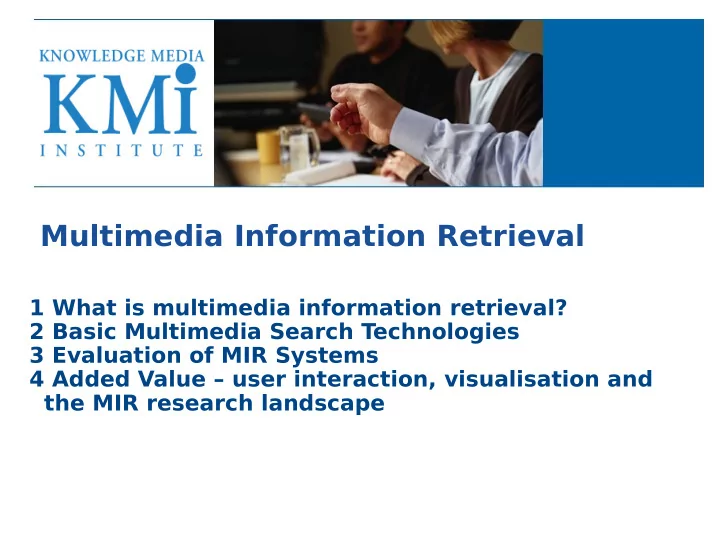

Multimedia Information Retrieval 1 What is multimedia information retrieval? 2 Basic Multimedia Search Technologies 3 Evaluation of MIR Systems 4 Added Value – user interaction, visualisation and the MIR research landscape
Multimedia Information Retrieval 1 What is multimedia information retrieval? 2 Basic Multimedia Search Technologies 3 Evaluation of MIR Systems 3.1 Metrics 3.2 Calculating and Comparing 3.3 Evaluation Campaigns 4 Added Value – user interaction, visualisation and the MIR research landscape
Evaluation How do we know if our MIR system is effective? Why do we care about quantifying the performance? “If you can not measure it, you can not improve it.” – Lord Kelvin
Information Retrieval “Cranfield Paradigm” query set ground truth data “gold standard” relevance judgement test train results list evaluation (M)IR tune train system metrics William Webber, ’When did the Cranfield tests become the “Cranfield paradigm”?’ http://blog.codalism.com/?p=817
Small, unbalanced data? Cross-validation test train Randomise data and divide train test Train-test 4 times train test Average all metrics 4-fold cross-validation test train Extreme is Leave-One-Out : test size = 1
Relevance? Find me pictures of triumph * * http://www.flickr.com/photos/ricardodiaz/
Exercise Find shots of printed, typed, or handwritten text, filling more than half of the frame area
Metrics Relevant Irrelevant Retrieved True Positive (tp) False Positive (fp) False Negative (fn) True Negative (tn) Not Retrieved Precision (P) = fraction retrieved that are relevant P = tp/(tp+fp) Recall (R) = fraction relevant that are retrieved R = tp/(tp+fn)
Precision or Recall? What about accuracy? Accuracy = (tp+tn)/(tp+fp+fn+tn) Is precision or recall more useful/important if I'm doing a web search on Gold Coast accommodation? if I'm a paralegal researching case precedence? How could I make a system with 100% recall? F 1 -measure (weighted harmonic mean of P & R)
Exercise An IR system returns 8 relevant documents and 10 irrelevant documents. There are a total of 20 relevant documents in the collection. Calculate the precision and recall.
Exercise An IR system returns 8 relevant documents and 10 irrelevant documents. There are a total of 20 relevant documents in the collection. Calculate the precision and recall. tp = 8 fp = 10 fn = 12 tn = (unknown) P = tp/(tp+fp) = 8/(8+10) = 8/18 = 0.44 R = tp/(tp+fn) = 8/(8+12) = 8/20 = 0.40 F 1 -measure would be 2x0.44x0.40/(0.44+0.40) = 0.42
Ranked Retrieval Which is better? There are 5 relevant documents to be found. System A System B 1. Relevant 1. Relevant 2. Relevant 2. Irrelevant 3. Irrelevant 3. Relevant 4. Irrelevant 4. Relevant 5. Relevant 5. Relevant 6. Relevant 6. Irrelevant Precision = 4/6 = 0.66 Precision = 4/6 = 0.66 Recall = 4/5 = 0.80 Recall = 4/5 = 0.80
Ranked Retrieval Metrics Precision @ N Precision/Recall graphs Mean Average Precision
Ranked Retrieval Which is better? There are 5 relevant documents to be found. System A System B 1. Relevant 1. Relevant P@1 2. Relevant 2. Irrelevant P@2 3. Irrelevant 3. Relevant P@3 4. Irrelevant 4. Relevant P@4 5. Relevant 5. Relevant P@5 6. Relevant 6. Irrelevant
Precision/Recall Curve
(Mean) Average Precision System A 1. Relevant P = 1 2. Relevant P = 1 3. Irrelevant - (1+1+0.6+0.67)/4 = 0.82 4. Irrelevant - 5. Relevant P = 0.6 6. Relevant P = 0.67 System B 1. Relevant P = 1 2. Irrelevant - 3. Relevant P = 0.67 (1+0.67+0.75+0.8)/4 = 0.69 4. Relevant P = 0.75 5. Relevant P = 0.8 6. Irrelevant -
Ranked Retrieval Which is better? There are 5 relevant documents to be found. System A System B 1. Relevant 1. Relevant 2. Relevant 2. Irrelevant 3. Irrelevant 3. Relevant 4. Irrelevant 4. Relevant 5. Relevant 5. Relevant 6. Relevant 6. Irrelevant AP = 0.82 AP = 0.69
Exercise Use the results (exercises/evaluation/) from 2 image search engines and calculate the performance. Which is better? Spreadsheet
The Dark Side of Evaluation ... Overfitting to limited training data → unbalanced, fragile system Unrealistic training data Difficulty in finding training data Comparison and competition Numbers not users
Evaluation Campaigns TRECVID ImageCLEF MediaEval MIREX
TREC Video retrieval conferences Organised by NIST with support from other U.S. government agencies - http://www-nlpir.nist.gov/projects/trecvid/ Objective is to encourage research in information retrieval by: Providing a large test collection. Uniform scoring procedures. Forum for organizations interested in comparing their results. T asks: Shot boundary detections (retired) High-level feature extraction (semantic annotation) Search (interactive, manually-assisted or fully automated) Rushes summarisation
TRECVID's dirty secret In the first few years of TRECVID video retrieval was best done with “text only” Image analysis did not help in early years BUT situation has changed! Combination of weak classifiers to corroborate evidence The number of visual concepts has increased; see, eg, LSCOM
TRECVid TRECVid example queries “Find shots of a road taken from a moving vehicle through the front window” “Find shots of a person talking behind a microphone” “Find shots of a street scene at night”
ImageCLEF CLEF = Cross Language Evaluation Forum Process is modelled from TREC ImageCLEF started in 2003 T asks: Image retrieval (queries in different languages) Medical Image Annotation Annotation of photographs Geographic retrieval (GeoCLEF) Video retrieval (VideoCLEF/MediaEval)
Search Engine Quality? System issues Indexing speed Scalability Robustness Query expressiveness User issues Diversity, Responsiveness “happiness” ? The interface vs IR performance
Multimedia Information Retrieval 1 What is multimedia information retrieval? 2 Basic Multimedia Search Technologies 3 Evaluation of MIR Systems 3.1 Metrics 3.2 Calculating and Comparing 3.3 Evaluation Campaigns 4 Added Value – user interaction, visualisation and the MIR research landscape
Recommend
More recommend